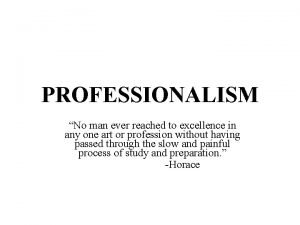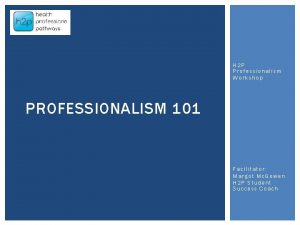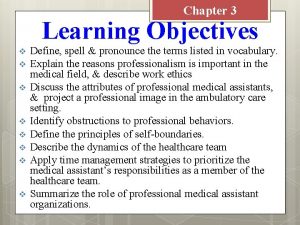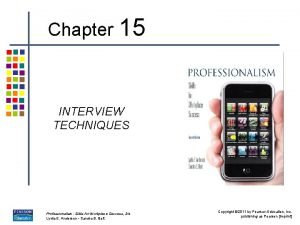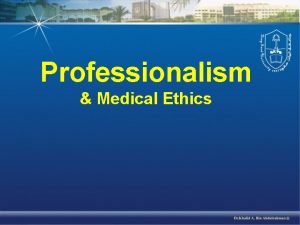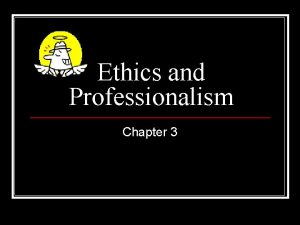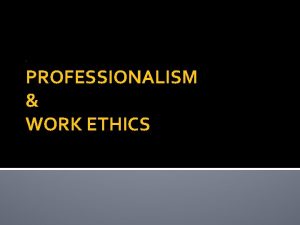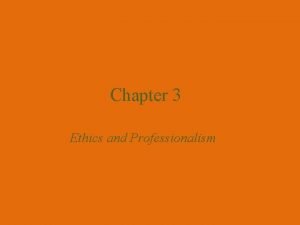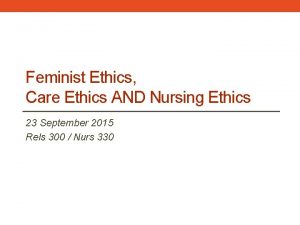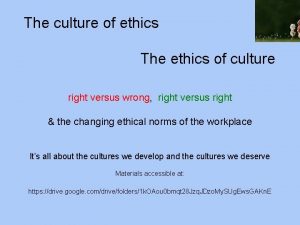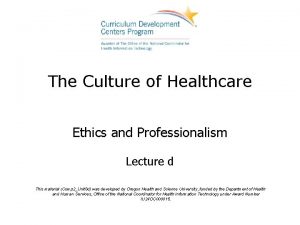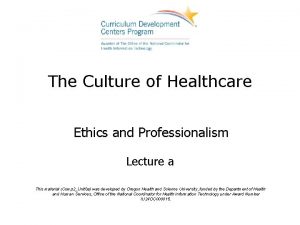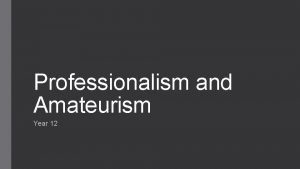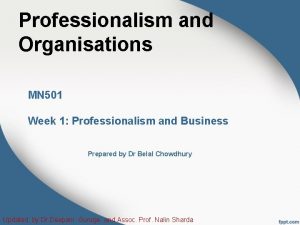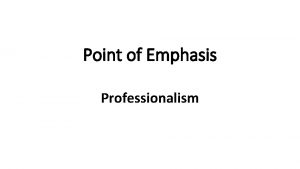The Culture of Health Care Ethics and Professionalism


























- Slides: 26


The Culture of Health Care Ethics and Professionalism Lecture b This material (Comp 2 Unit 8) was developed by Oregon Health & Science University, funded by the Department of Health and Human Services, Office of the National Coordinator for Health Information Technology under Award Number IU 24 OC 000015. This material was updated in 2016 by Bellevue College under Award Number 90 WT 0002. This work is licensed under the Creative Commons Attribution-Non. Commercial-Share. Alike 4. 0 International License. To view a copy of this license, visit http: //creativecommons. org/licenses/by-nc-sa/4. 0/.

Ethics and Professionalism Learning Objectives • Discuss foundational concepts in medical ethics and professionalism (Lecture a). • Examine the relationships among ethical ideals, professionalism, and legal duties (Lecture a, b). • Apply the general principles of ethics and professionalism to specific topics (Lecture c, d). • Examine ethical issues in health informatics (Lecture d). 3

Ethical Standards and Legal Standards • Sometimes they are the same – Example: Both law and ethics prohibit harmful surgery on a healthy patient • Sometimes they overlap or interact – Example of overlap: State and federal laws set standards for the practice of medicine – Example of interaction: Failure to meet professional standards can create legal liability (malpractice case) • Sometimes they conflict – Example: Court orders disclosure of patient information 4

AMA Opinion • • Ethical values and legal principles are closely related Ethical obligations typically exceed legal duties Sometimes the law mandates unethical conduct Generally, physicians should obey current laws and work to change unjust laws • In rare cases, ethical responsibilities should take priority over unjust laws • Even if a legal proceeding finds a physician to be innocent, he or she may have acted unethically 5

Standards of Professionalism 8. 4 Figure: Standards of professionalism (CC BY-NC-SA 3. 0, 2012). 6

State Medical Practice Law • Defines the practice of medicine within the state • Establishes a state medical board • Governs testing and licensing of physicians • Specifies procedures for investigation, enforcement, and discipline of physicians 7

State Medical Board • The majority of the members are physicians, but should also include nonphysicians • Writes rules and regulations • Gives examinations and awards medical licenses • Investigates complaints, holds hearings • Administers disciplinary actions • Evaluates medical education programs 8

Unprofessional Conduct • Investigators gather information • Board determines whether unprofessional conduct has occurred • Board imposes sanctions – Fines – Mandatory medical education – Mandatory medical treatment – Suspension or revocation of license 9

Investigation vs. Malpractice • State medical board investigation – Addresses physician’s responsibility to the medical profession • Malpractice lawsuit – Addresses physician’s liability to patient • The same act or situation may result in both an investigation and a lawsuit 10

Four Basics of Malpractice • Health care provider had a duty to the patient • Minimum standards of care were not met • The failure to meet standards of care caused an injury • The injury resulted in damages (harm) 11

Professionalism and the Culture of Health Care • Lofty goals can compete with fear of potential consequences • Prevailing attitudes in the health care culture can make it difficult to uncover ethical lapses 12

The Hidden Curriculum in Medical Education • The “culture” of a medical school can contradict formal medical ethics training • Students learn by: – “Reading between the lines” of written institutional policies – Observing standards used for evaluation of success – Following the money – Noticing the language an institution uses 13

How the Hidden Curriculum Is Taught • Institutional policies – Statements about how much federal grant money the faculty is generating tell students that attracting money to the institution is an important value • Evaluation activities – The attributes and behaviors of those who are promoted may be more influential than ethics statements 14

How the Hidden Curriculum Is Taught Continued • Resource-allocation decisions – Office space – Which programs are funded • Institutional language about money 15

Barriers to Disclosing Unethical Behavior • Personal motivations – Loyalty to the profession • Institutional motivations – Fear of negative publicity associated with a scandal • Understandings about physician behavior – Be confident and exercise independent judgment – Do not raise concerns with others 16

Whistleblowing and Health Care Ethics • Generally, about 6 out of 10 people who observe workplace misconduct will report it • The percentage may be even lower in the health care field – Fewer than 5% of medical students in their last weeks of training said they would report unethical behavior 17

Funds Recovered Due to Whistleblowing in 2015 8. 5 Chart: Health care fraud Of the $3. 5 billion recovered, $1. 9 billion was related to health care fraud Department of Justice, 2015 18

Retaliation for Whistleblowing • About 15% of whistleblowers face retaliation • Can range from mild to severe, for example: – Snubbed by coworkers – Verbal abuse by supervisor – Denied promotion or raises – Property damage – Physical assault 19

Protection of Whistleblowers Federal Law False Claims Act Occupational Safety and Health Act Clean Air Act Solid Waste Disposal Act Example of When It Applies A false claim for payment has been made, such as Medicare fraud Practices that result in an unsafe workplace Practices that contribute to air pollution Improper disposal of solid waste 8. 6 Table: Protection of whistleblowers (CC BY-NC-SA 3. 0, 2012). 20

Ethics and Professionalism Summary – Lecture b • Health care professionals must meet both ethical and legal standards – Sometimes these standards are the same, but not always • The sources of legal standards for health care professionals include state medical practices laws and malpractice law • The culture of health care includes expectations that may make it difficult to disclose illegal or unethical behavior or practices 21

Ethics and Professionalism References – Lecture b References Aasland, O. G. , & Forde, R. (2005). Impact of feeling responsible for adverse events on doctors’ personal and professional lives: The importance of being open to criticism from colleagues. Quality and Safety in Health Care, 14(1), 13– 17. American Medical Association. (2012). The AMA Code of Medical Ethics' Opinions on Confidentiality of Patient Information. Opinion E-5. 05—Confidentiality. AMA Journal of Ethics. Retrieved from http: //journalofethics. ama-assn. org/2012/09/coet 1 -1209. html American Medical Association. (2016). AMA’s code of medical ethics. Retrieved from http: //www. amaassn. org/ama/pub/physician-resources/medical-ethics/code-medical-ethics. page American Medical Association. (2016). Frequently asked questions in ethics. Retrieved from http: //www. ama-assn. org/ama/pub/physician-resources/medical-ethics/code-medicalethics/frequently-asked-questions. page Benatar, D. (2006). Bioethics and health and human rights: a critical view. Journal of Medical Ethics, 32(1), 17– 20. Retrieved from http: //www. ncbi. nlm. nih. gov/pmc/articles/PMC 2563274/ Bolsin, S. , Faunce, T. , & Oakley, J. (2005). Practical virtue ethics: Healthcare whistleblowing and portable digital technology. Journal of Medical Ethics, 31(10), 612– 618. Brock, L. V. , & Mastroianni, A. (2013). Clinical ethics and law. University of Washington School of Medicine. Retrieved from https: //depts. washington. edu/bioethx/topics/law. html Center for Practical Bioethics. (n. d. ). What is bioethics? Retrieved from https: //www. practicalbioethics. org/what-is-bioethics 22

Ethics and Professionalism References – Lecture b Continued The Economist. (2014, May 31). The $272 billion swindle. Why thieves love America’s health-care system. Retrieved from http: //www. economist. com/news/united-states/21603078 -why-thieves-love -americas-health-care-system-272 -billion-swindle Ethics & Compliance Initiative. (n. d. ). Ethics and compliance glossary. Retrieved from https: //www. ethics. org/resources/free-toolkit/toolkit-glossary Farnan, J. M. , Sulmasy, L. S. , Worster, B. K. , Chaudhry, H. J. , Rhyne, J. A. , & Arora, V. M. (2013). Online medical professionalism: Patient and public relationships: Policy statement from the American College of Physicians and the Federation of State Medical Boards. Annals of Internal Medicine, 158(8), 620– 627. Federation of State Medical Boards. (2015). Essentials of a state medical and osteopathic practice act. Retrieved from http: //www. fsmb. org/Media/Default/PDF/FSMB/Advocacy/GRPOL_essentials. pdf Gillon, R. , & Higgs, R. (2015). What is it to do good medical ethics? A kaleidoscope of views. Journal of Medical Ethics, 41(1), 1– 4. Grunwald H. W. , Howard D. S. , Mc. Cabe M. S. , Storm C. D. , & Rodriguez M. A. (2008) Misdiagnosis: Disclosing a colleague’s error. Journal of Oncology Practice, 4(3), 158– 160. Hafferty FW. (1998) Beyond curriculum reform: confronting medicine's hidden curriculum. Academy of Medicine, 73(4): 403– 407 23

Ethics and Professionalism References – Lecture b Continued 2 Hannawa, A. F. (2012). Principles of medical ethics: implications for the disclosure of medical errors. Medicolegal and Bioethics, 2, 1– 1. Retrieved from https: //www. researchgate. net/profile/ Annegret_Hannawa 2/publication/232252062_Principles_of_medical_ethics_Implications_for_the_ disclosure_of_medical_errors Kesselheim, A. S. , Studdert, D. M. , & Mello, M. M. (2010). Whistle-blowers’ experiences in fraud litigation against pharmaceutical companies. New England Journal of Medicine, 362(19), 1832– 1839. Retrieved from http: //www. nejm. org/doi/full/10. 1056/nejmsr 0912039 Klaas, P. B. , Berge, K. H. , Klaas, K. M. , Klaas, J. P. , & Larson, A. N. (2014). When patients are harmed, but are not wronged: Ethics, law, and history. Mayo Clinic Proceedings, 89(9), 1279– 1286. Krause, J. H. (2013). Kickbacks, self-referrals, and false claims: The hazy boundaries of health-care fraud. CHEST Journal, 144(3), 1045– 1050. Retrieved from http: //journal. publications. chestnet. org/ article. aspx? articleid=1732168 Lyons, C. (2012). Medical malpractice apology law: “Don’t tell me what happened, tell me that you’re sorry. ”. Health Law Outlook, 27. Retrieved from http: //scholarship. shu. edu/cgi/viewcontent . cgi? article=1006&context=health_law_outlook#page=27 Macklin, R. (2015). Can one do good medical ethics without principles? Journal of Medical Ethics, 41, 75– 78. Retrieved from http: //jme. bmj. com/content/41/1/75. full Mannion, R. , & Davies, H. T. (2015). Cultures of silence and cultures of voice: The role of whistleblowing in healthcare organisations. International Journal of Health Policy and Management, 4(8), 503. Retrieved from http: //www. ncbi. nlm. nih. gov/pmc/articles/PMC 4529038 24

Ethics and Professionalism References – Lecture b Continued 3 Outterson, K. (2012). Punishing health care fraud—Is the GSK settlement sufficient? . New England Journal of Medicine, 367(12), 1082– 1085. Pickler N. (2011, December 19). Justice reports record false claims recoveries. Yahoo Finance News. Retrieved from http: //finance. yahoo. com/news/Justice-reports-record-false-apf 3660225829. html? x=0 Rhodes, R. , & Strain, J. J. (2004). Whistleblowing in academic medicine. Journal of Medical Ethics, 30(1), 35– 39. U. S. Department of Justice (2015). Justice Department recovers over $3. 5 Billion from False Claims Act cases in fiscal year 2015. Retrieved from https: //www. justice. gov/opa/pr/justice-departmentrecovers-over-35 -billion-false-claims-act-cases-fiscal-year-2015 Vincler, L. A. (2013). Ethics in medicine: Clinical ethics and law. University of Washington School of Medicine. Retrieved from http: //depts. washington. edu/bioethx/topics/law. html Wallace, I. M. (2015). Is patient confidentiality compromised with the electronic health record? : A position paper. Computers Informatics Nursing, 33(2), 58– 62 Charts, Tables, Figures 8. 4 Figure: Standards of professionalism (CC BY-NC-SA 3. 0, 2012). 8. 5 Chart: Health care fraud (CC BY-NC-SA 3. 0, 2016). 8. 6 Table: Protection of whistleblowers (CC BY-NC-SA 3. 0, 2012). 25

The Culture of Health Care Ethics and Professionalism Lecture b This material was developed by Oregon Health & Science University, funded by the Department of Health and Human Services, Office of the National Coordinator for Health Information Technology under Award Number IU 24 OC 000015. This material was updated in 2016 by Bellevue College under Award Number 90 WT 0002. 26
 Health and social care component 3 health and wellbeing
Health and social care component 3 health and wellbeing Care value base health and social care
Care value base health and social care Primary secondary and tertiary health care
Primary secondary and tertiary health care Ac 61-98 plan of action
Ac 61-98 plan of action Discuss principles of professionalism
Discuss principles of professionalism Integrity and professionalism
Integrity and professionalism Difference between micro ethics and macro ethics
Difference between micro ethics and macro ethics Business communication chapter 2
Business communication chapter 2 Popular culture examples
Popular culture examples Batch culture vs continuous culture
Batch culture vs continuous culture Difference between american culture and indian culture
Difference between american culture and indian culture Stroke culture method
Stroke culture method Folk culture and popular culture venn diagram
Folk culture and popular culture venn diagram Examples of mass culture
Examples of mass culture Indole test
Indole test Folk culture and popular culture venn diagram
Folk culture and popular culture venn diagram Stroke culture method
Stroke culture method Carpet culture method
Carpet culture method Surface culture deep culture and esol
Surface culture deep culture and esol No professionalism
No professionalism Domain 4 examples
Domain 4 examples Professionalism workshop
Professionalism workshop Professionalism definition
Professionalism definition Self boundaries for medical assistants
Self boundaries for medical assistants Professionalism skills for workplace success
Professionalism skills for workplace success Attributes of professionalism
Attributes of professionalism What is professionalism
What is professionalism



















